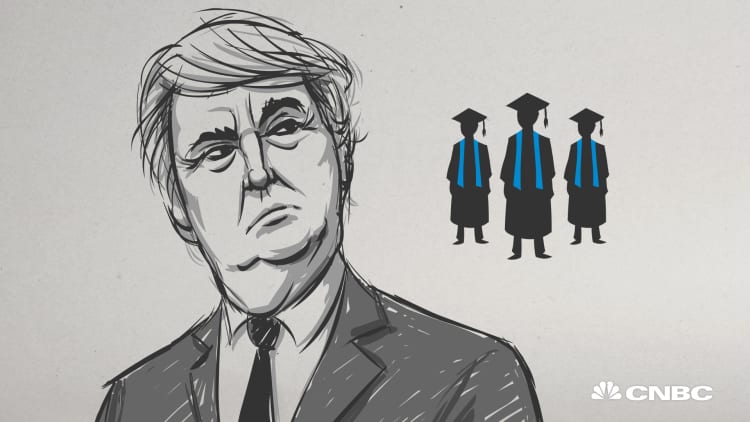
Low-income student loan borrowers might notch a win under President-elect Donald Trump's federal student loan repayment program.
Researchers at NerdWallet, a personal finance website, compared Trump's proposed student loan repayment program and the Revised Pay as You Earn income-driven repayment plan.
Trump's proposal calls for borrowers to pay 12.5 percent of their annual income toward the loan. Debtors may have their loans forgiven after 15 years in the plan.
By contrast, REPAYE calls for borrowers to pay 10 percent of their income and permits forgiveness after 20 or 25 years of repayment, depending on whether the loan was taken out for undergraduate or graduate study.
Only federal loans qualify for income-driven repayment programs like REPAYE.
NerdWallet's study found that while borrowers pay down their debts faster under Trump's plan, they're coughing up more money each month to do so.
Still, low-income borrowers are likely to benefit from this plan because their debts are forgiven after 15 years as opposed to 20 or 25.
"Those who are at the lower income levels benefit the most under Trump's plan," said Brianna McGurran, who specializes in student loans at NerdWallet.
"When you have a lower income, you're more likely to take the full amount of time to repay your loans and receive forgiveness at the end," she said.
Month by month
In its analysis, NerdWallet modeled repayment schedules for debtors earning $20,000, $30,000 and $40,000 a year.
In all cases, each borrower held $30,100 in total student loan debt, based on data from The Institute for College Access and Success.
Researchers assumed that about 80 percent of that debt load — roughly $24,000 — was attributable to federal loans with an interest rate of 4.1 percent.
The chart below measures the average monthly student loan payments by income level, under Trump's plan and the REPAYE program.
Debtors would shell out more each month under the Trump plan. Those earning $20,000 a year can expect to pay an average of $8 more per month under that program than under REPAYE, according to NerdWallet.
Meanwhile, those earning $40,000 a year will pay up $43 more each month on average under Trump's plan, according to the study.
The payoff
The larger payments help debtors get out from under their loans sooner.
For instance, NerdWallet's analysis found that while an individual earning $30,000 a year would pay off the federal loan in 18.9 years under the REPAYE program, he or she could pay down the debt in 14.6 years under the Trump plan.
The payoff for lower-income borrowers, however, is that they reach forgiveness sooner under the Trump plan and they pay less money overall.
According to the analysis, a debtor earning $20,000 would have loans forgiven under either the REPAYE or Trump plan.
Over the course of 20 years, someone who originally borrowed about $24,000 in federal loans at an interest rate of 4.1 percent, will pay $14,166 toward what is owed under the REPAYE program, with $35,041 forgiven.
On the other hand, under Trump's plan, this same person will have paid $12,046 over 15 years and have $29,543 forgiven. See the chart below.
It's important to note that the most aggressive repayment plan may not be the best one for you, especially if you're on an income-driven repayment plan because you're already strapped for cash.
"When you look at the monthly contribution, that can be a big difference for someone who is living paycheck to paycheck or who needs an extra $30 to $50 for an electric bill," McGurran said.


